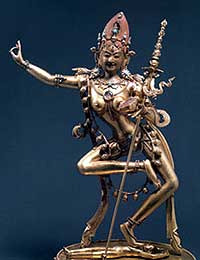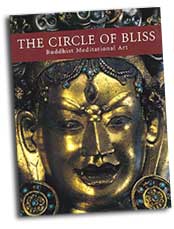 Almost four decades after the last travelling Nepali art exhibition to the west, The Circle of Bliss: Buddhist Meditational Art is on display at Los Angeles. This unparalleled collection of almost 160 Nepali, Indian, Tibetan, Chinese and Mongolian masterpieces, some dating back 13 centuries, has been well received by media critics and some 20,000 visitors have thronged to the museum.
Almost four decades after the last travelling Nepali art exhibition to the west, The Circle of Bliss: Buddhist Meditational Art is on display at Los Angeles. This unparalleled collection of almost 160 Nepali, Indian, Tibetan, Chinese and Mongolian masterpieces, some dating back 13 centuries, has been well received by media critics and some 20,000 visitors have thronged to the museum. Co-curator Dina Bangdel, assistant professor at Ohio State University, is ecstatic. "Given the political situation here, I feel that this exhibition has established for Nepal a much needed positive presence in the US with a very favourable response," she told us. "With Nepal so much in the forefront in the US, we should take pride in our cultural heritage."
The exhibition focuses on the context of the art and translates Himalayan Buddhist practices into physical form. Bangdel and colleague John C Huntington have also published a catalogue Circle of Bliss that helps visitors understand the artwork that flow from the Himalayan Buddhist tradition.
Modern art museums almost always leave interpretation-whether we invest art with meaning or not-to the viewer, so this guided exhibition to an understanding of the display is a rarity. Meditational art is both meaningful and with purpose: their creators knew the function of each piece was solely to aid the practitioner to attain enlightenment through meditation.
Currently on display at the Los Angeles County Museum of Art, the exhibition focuses on Chakrasamvara and Vajravarahi, regarded by some as key Tantric mediation practices. The artwork is exquisite and esoteric. Using graphic and explanatory panels, the organisers have made accessible an art form that has only been studied for the past 60 years.
 The Circle of Bliss offers a historical scholarship of Tantra, in particular Chakrasamvara Tantra. Though the texts have been around, offering meditation technique for centuries, co-authors Bangdel and Huntington have placed the art in their religious and social context, emphasising their symbolic visual language.
The Circle of Bliss offers a historical scholarship of Tantra, in particular Chakrasamvara Tantra. Though the texts have been around, offering meditation technique for centuries, co-authors Bangdel and Huntington have placed the art in their religious and social context, emphasising their symbolic visual language. While tracing the geographic and cultural development of Himalayan Buddhism across Asia, the authors examine the role of the Newar Buddhist community in Nepal as transmitters and interpreters of tantric teachings. The Newars are reintroduced as a catalyst in the development of Buddhism. The links are apparent in the 13 works of art that have travelled to LA from Nepal's national collection. All told, 40 international museums and private collectors from Nepal, North America, Great Britain and Europe have loaned art pieces: sculptures, thangkas, books, ritual instruments-it's all there.
Reliefs of Buddha's birth dating to the 5th or 6th century, lent by the National Museum in Chhauni, is one of the oldest works on display. At the core of the exhibition, are various examples of the two deities Chakrasamvara (which translates as 'circle of bliss') and his consort Vajravarahi entwined in a love embrace.
Aside from paintings and sculptures, the exhibit's chief attraction is the on-site creation of the Circle of Bliss sand madala being made by Tibetan monks from the Ganden monastery in India. The 8m diameter sand mandala will be completed this week and then destroyed, its constituents sprinkled over the Pacific Ocean.
The Circle of Bliss will leave Los Angeles County Museum of Art on 4 January and travel to Ohio.


